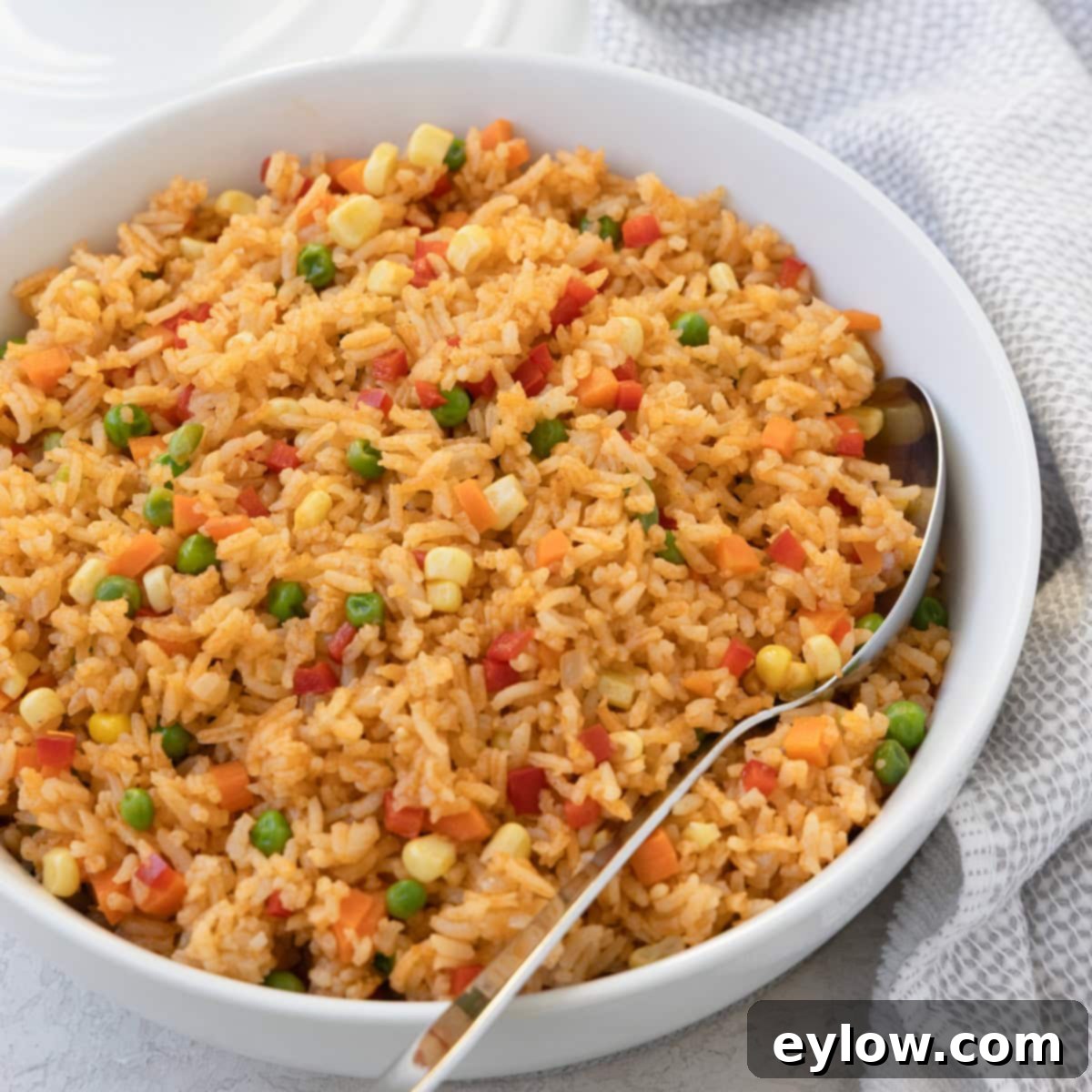Flavorful and Easy Mixed Vegetable Rice: Your Go-To Side Dish for Any Meal
Mixed vegetable rice is more than just a side dish; it’s a vibrant celebration of flavors and colors, much like a festive bowl of rice pilaf. Imagine a confetti of fresh or frozen vegetables—sweet peas, tender carrots, crisp red bell pepper, and juicy corn—all coming together in a harmonious medley. This delightful dish is not only delicious but also a feast for the eyes, bursting with lively hues that brighten up any plate. While this particular recipe draws inspiration from Mexican-style flavors, it’s incredibly versatile and can be easily adapted to a milder, more universal taste profile, making it a perfect accompaniment to a wide range of cuisines. Cooked expertly with rich chicken or vegetable broth instead of plain water, it ensures every grain of rice is infused with an extra layer of savory depth. Whether you’re looking for a convenient option for meal prep, a fantastic make-ahead dish for busy days, or something that freezes beautifully for future enjoyment, this easy vegetable rice recipe is a true kitchen winner that promises both flavor and convenience.
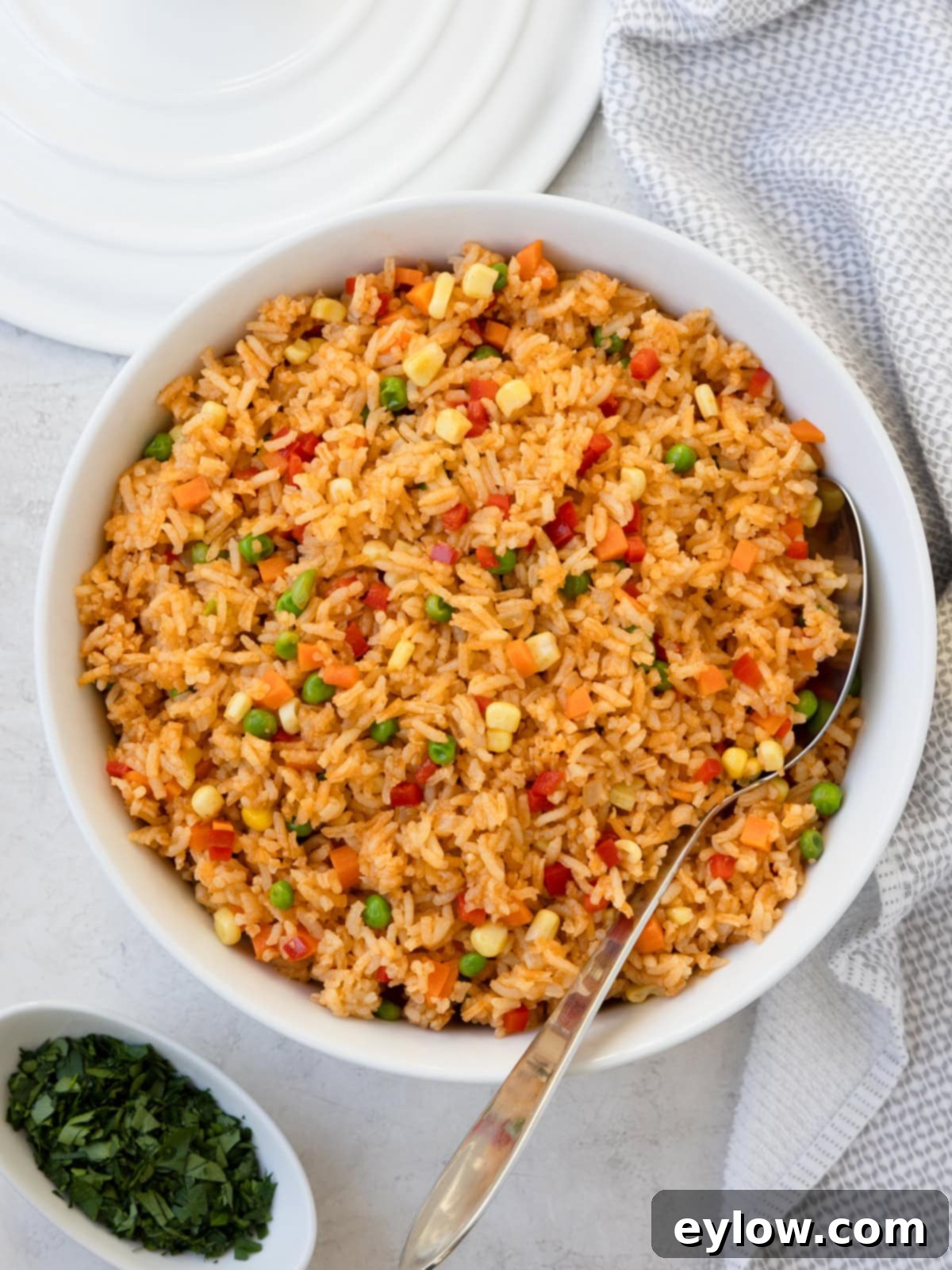
This vibrant mixed vegetable rice is a staple for those who appreciate both taste and practicality. Its exceptional keeping qualities make it ideal for meal planning: it stays fresh and flavorful in the refrigerator for up to four days, and it freezes beautifully for up to three months, providing a quick and healthy option during hectic weeks. There’s a special comfort in a perfectly cooked pot of rice, and this easy vegetable rice recipe elevates that comfort to an entirely new level, transforming a simple grain into a colorful, nutritious, and satisfying dish that’s far from ordinary. It’s a smart choice for anyone seeking to add more vegetables and flavor to their diet without compromising on time or convenience.
Why You’ll Love This Flavorful Vegetable Rice Recipe
This mixed vegetable rice isn’t just another side; it’s a dish designed to delight and simplify your cooking routine. Here’s why it’s destined to become a favorite in your kitchen:
- Colorful, Flavorful, and Effortlessly Easy Side Dish: This recipe delivers a visual spectacle with its bright array of vegetables, making every plate pop with color. Beyond its aesthetic appeal, it’s packed with savory flavors that complement a wide range of main courses. The simplicity of the cooking process ensures that even novice cooks can achieve perfect results, adding a gourmet touch without the fuss.
- Excellent for Meal Prep and Make-Ahead Convenience: Say goodbye to last-minute cooking stress! This vegetable rice is a dream for meal preppers. You can cook a large batch at the beginning of the week and enjoy wholesome, ready-to-eat meals for days. Its robust flavor only seems to deepen after a day or two in the fridge, making it an ideal component for healthy packed lunches or quick dinners.
- Freezes Exceptionally Well: For ultimate convenience, this dish is a freezer superstar. Portion out leftovers into airtight containers, and you’ll have delicious, healthy meals on standby for up to three months. This feature is a game-changer for busy individuals or families who want to ensure they always have nutritious options available without constant cooking.
- Far More Exciting Than Plain Rice: Transform your ordinary rice experience into something extraordinary. The addition of aromatic spices and a vibrant mix of vegetables elevates this dish beyond a simple carbohydrate, offering layers of texture, flavor, and nutritional value that plain rice simply cannot. It’s an easy way to sneak more veggies into your diet in a truly enjoyable way.
- Versatile with Both Frozen and Fresh Vegetables: This recipe embraces flexibility. Whether you have a bounty of fresh produce from the garden or a well-stocked freezer, you can use either fresh or frozen vegetables. This adaptability ensures you can make this delicious rice dish year-round, always taking advantage of what’s convenient and in season.
If you enjoy the rich and zesty notes of Mexican cuisine, you might also love this chicken tortilla soup, which is incredibly easy to prepare using either leftover chicken or a convenient store-bought rotisserie chicken. It’s another fantastic dish that combines comfort and flavor with ease.
Essential Ingredients for Perfect Vegetable Rice
Crafting this delicious and colorful vegetable rice requires a thoughtful selection of ingredients. Here’s a breakdown of what you’ll need and why each component is key to achieving that perfect balance of flavor and texture:
- Rice: The foundation of our dish! I specifically developed this recipe using basmati, a white long-grain rice, known for its distinct aroma and ability to cook up light, fluffy, and with beautifully separate grains. This characteristic is crucial for the desired texture of our vegetable rice, preventing it from becoming clumpy or mushy. While other rice varieties might work in a pinch, they won’t yield the same ethereal fluffiness. For instance, jasmine rice is softer and can be a bit stickier, leading to more clumping. I haven’t tested this recipe with brown rice, as brown rice requires significantly longer cooking times and more liquid, making it a less direct substitute without major adjustments.
- Oil: For sautéing and building the flavor base, opt for extra virgin olive oil or avocado oil. Both are excellent choices due to their healthy fat profiles and relatively high smoke points, which are suitable for medium-heat cooking. What should you avoid? Standard vegetable oil, as it often lacks the nuanced flavor and health benefits of its counterparts.
- Broth: The secret to truly flavorful rice! Chicken broth or vegetable broth adds a crucial layer of depth and savory notes that water simply cannot provide. Using broth infuses every grain of rice with a rich base flavor, making the dish much more satisfying. For a vegetarian or vegan version, ensure you use a good quality vegetable broth.
- Onion: A fundamental aromatic. White onions are preferred here because of their mild flavor, which sweetens beautifully when sautéed without overpowering the other ingredients. Finely chopped, they become tender and translucent, forming an excellent foundation.
- Garlic: Fresh garlic is indispensable for that pungent kick and aromatic warmth. Minced garlic quickly releases its intense flavor when gently cooked with the onions, contributing significantly to the overall taste profile.
- Spices: To achieve a subtly Mexican-inspired flavor, we use ground cumin and ground coriander. Cumin offers an earthy, warm note, while coriander brings a hint of citrus and sweetness. For those who enjoy a little heat, a pinch of red pepper flakes can be added, allowing you to customize the spice level to your preference.
- Tomato Paste: This concentrated ingredient is a powerhouse for adding depth of flavor, a rich umami note, and a beautiful, subtle reddish hue to the rice, enhancing both its taste and visual appeal.
- Peas: Petite green peas are a wonderful addition for their sweet, tender pop of flavor and vibrant green color. Frozen peas work perfectly here and are incredibly convenient; just ensure they are thawed before adding them.
- Corn: Frozen corn kernels bring a delightful sweetness and additional texture to the rice. Like peas, they are a convenient frozen option that adds a sunny yellow color and a burst of juicy flavor. Thawing them beforehand is recommended.
- Carrots: Finely chopped carrots contribute natural sweetness, a pleasant crunch, and a striking orange (or even red or purple, if you’re adventurous!) color. They add nutritional value and visual interest to the dish.
- Bell Pepper: Red bell peppers are my go-to for their sweetness and bright color, but any color bell pepper will work beautifully. Green bell pepper offers a slightly more assertive, less sweet flavor, which is also a great option if you prefer. Whichever you choose, finely chopping it ensures it blends seamlessly with the rice.
- Fresh Herbs: A sprinkle of fresh chopped cilantro or parsley at the end is not just a garnish; it adds a burst of garden freshness and a final touch of vibrant color, elevating the dish’s aroma and taste.
For precise measurements of all ingredients, including salt and black pepper, please refer to the comprehensive recipe card located at the end of this article.
Chef’s Tip – Brown Rice vs. White Rice: If you’re considering using brown rice in this recipe, it’s important to note that brown rice takes significantly longer to cook and requires a different liquid-to-rice ratio compared to white rice. Therefore, it won’t work as a direct substitute using the exact method outlined here. If you prefer to use brown rice, I recommend cooking it separately according to its package instructions until it’s nearly done. Then, you can stir the cooked brown rice into the sautéed vegetables and seasonings during the final stages of this recipe to combine flavors and finish cooking. While the texture and timing will be different, it will still result in a delicious and hearty vegetable rice dish.
Exciting Substitutions and Flavorful Variations
One of the best aspects of this mixed vegetable rice recipe is its incredible adaptability. Feel free to experiment with these suggestions to suit your taste, dietary needs, or what you have on hand:
- For a Simpler Flavored Vegetable Rice: If you prefer a milder taste profile or are serving alongside a main dish with bold flavors, you can easily omit the ground cumin, ground coriander, and tomato paste. This will result in a rice dish with a clean, subtle flavor that highlights the natural sweetness of the vegetables and the richness of the broth.
- Add Saffron for Golden Color and Exquisite Flavor: For a touch of luxury and a beautiful golden hue, infuse a pinch of saffron threads into your broth before adding it to the rice. Saffron imparts a delicate, earthy, and floral aroma that transforms the dish into something truly special, reminiscent of a delicate risotto.
- For More Mexican Flavor and Heat: If you’re craving an extra kick and a more pronounced Mexican profile, finely chopped jalapeño pepper is your answer. Add it along with the onion and garlic to allow its flavors to meld and its heat to soften slightly. For even more heat, leave some of the seeds in, or use a serrano pepper.
- Utilize a Frozen Vegetable Mix: For ultimate convenience, replace the individual frozen peas, corn, carrots, and bell pepper with 2 cups of your favorite thawed frozen mixed vegetables. This is a fantastic time-saver, perfect for busy weeknights, and ensures a balanced variety of nutrients.
- Alternate Vegetable Choices: Don’t limit yourself to the suggested vegetables! This recipe is incredibly forgiving. Consider adding finely chopped fresh zucchini, green beans, broccoli florets, or even spinach or kale (stirred in at the very end to wilt) for additional nutrients and textural contrast. Diced sweet potatoes or butternut squash can also be wonderful additions, offering extra sweetness and heartiness.
- Transform into a Main Dish with Added Protein: Make this vegetable rice a complete meal by stirring in cooked protein. Excellent options include shredded rotisserie chicken, sautéed shrimp, grilled tofu cubes, black beans, or even a can of rinsed and drained chickpeas. Add these towards the end of the cooking process, allowing them to warm through with the rice and vegetables.
Here’s the perfect easy entree to serve alongside this versatile vegetable rice: my incredibly flavorful chicken salsa verde! You can whip it up in just 20-30 minutes, making for a quick, delicious, and well-rounded meal.
Step-by-Step Guide: How to Make Perfect Vegetable Rice
Achieving fluffy, flavorful vegetable rice is simpler than you might think. Follow these easy steps for a dish that’s consistently delicious and beautifully cooked:
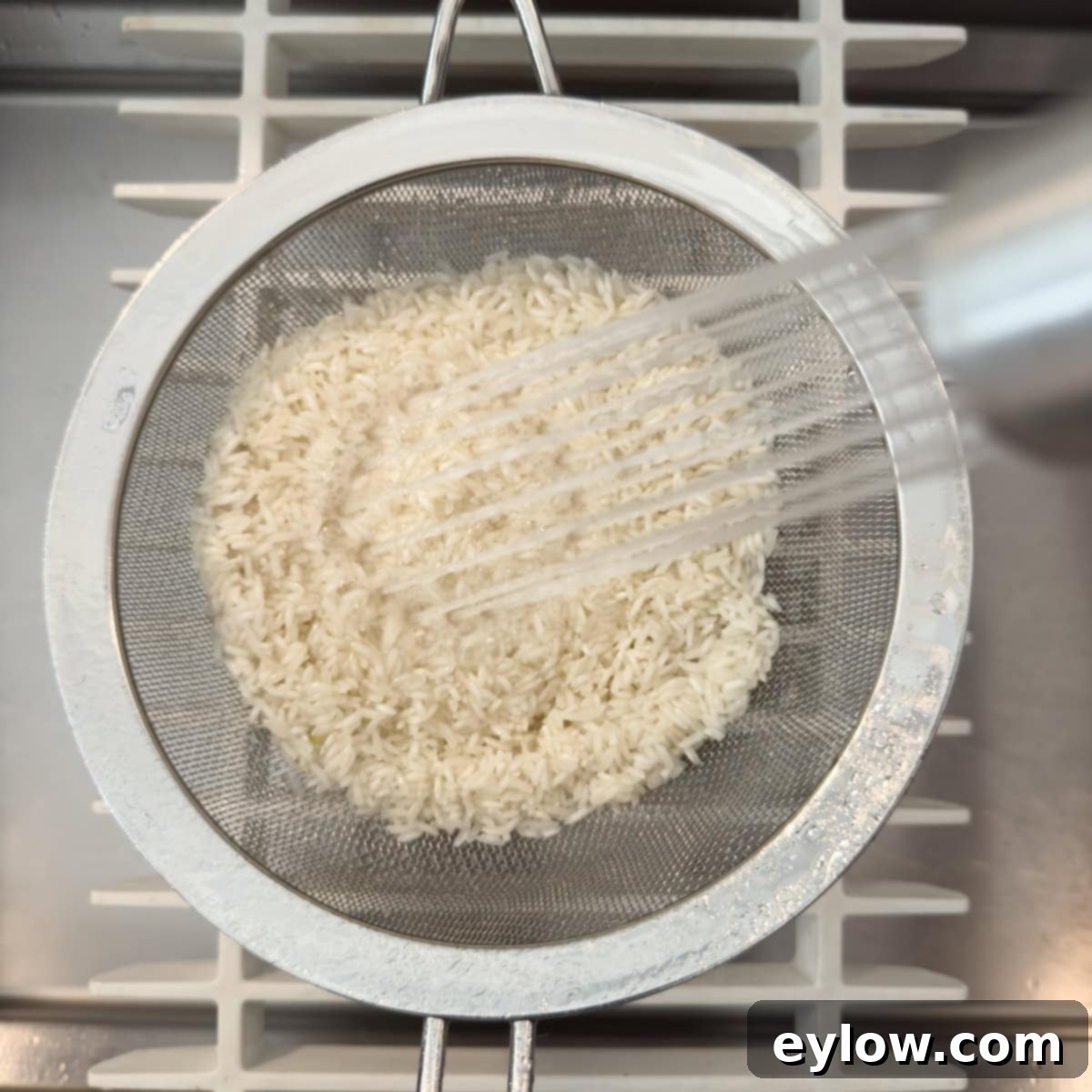
1. **Rinse the Rice Thoroughly:** Place the basmati rice in a fine-mesh sieve. Rinse it under cold running water for at least one minute, using your fingers to gently swish it around. Continue rinsing until the water runs mostly clear. This step is crucial for removing excess starch, which helps prevent the rice from becoming sticky or mushy during cooking. Once rinsed, drain it very well and set aside.
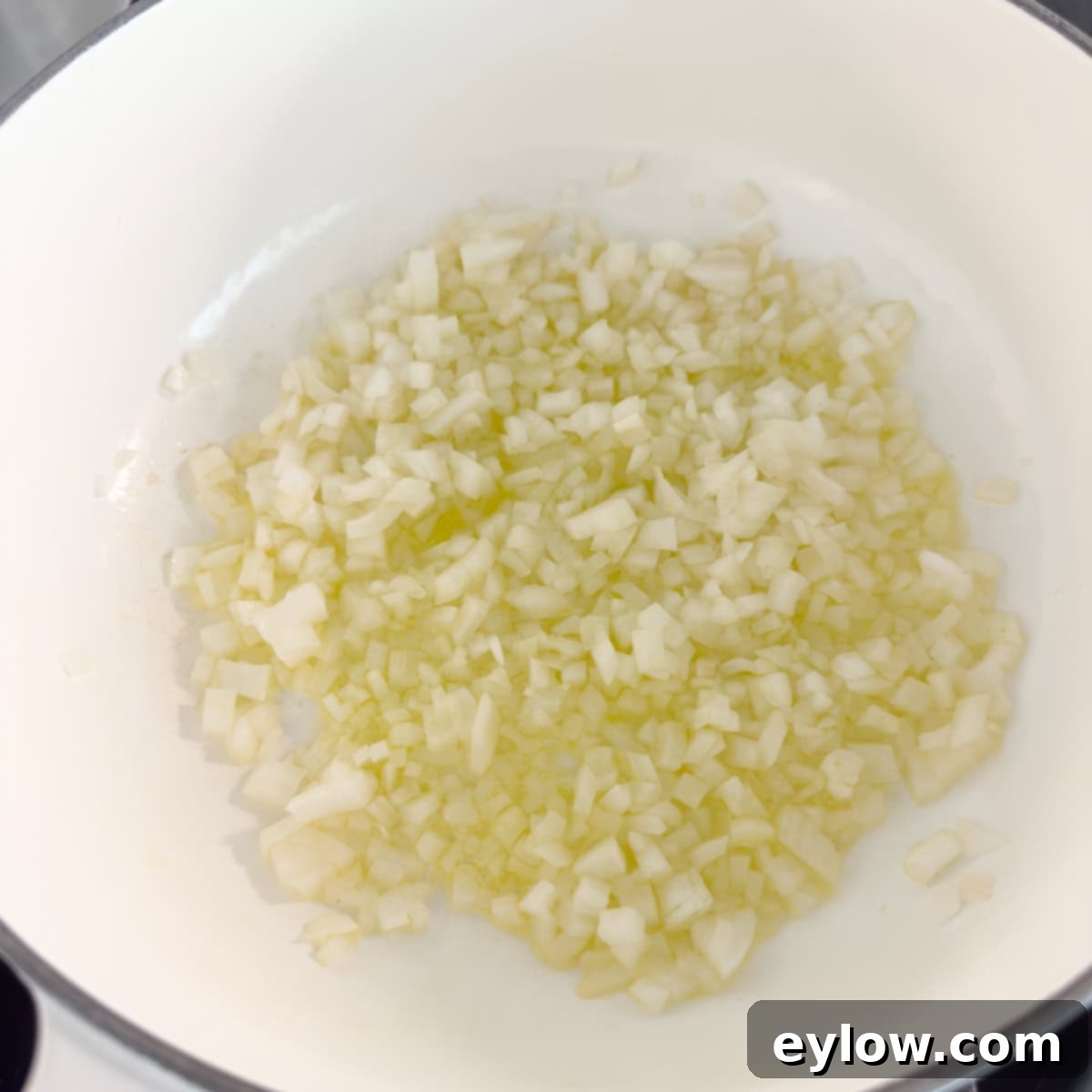
2. **Sauté the Aromatics:** In a heavy-bottomed pot (a Dutch oven or thick-bottomed saucepan works best to prevent scorching), heat the olive or avocado oil over medium heat. Add the finely diced white onion and sauté, stirring occasionally, for 3-4 minutes until it becomes soft and translucent. Be careful not to let it brown too much; reduce the heat if necessary. Then, add the minced garlic and cook for another minute until fragrant, being careful not to burn it.

3. **Bloom the Spices and Tomato Paste:** Stir in the ground cumin, ground coriander, tomato paste, sea salt, and black pepper (and red pepper flakes if using). Cook for 1-2 minutes, stirring constantly. This step allows the spices to “bloom” in the hot oil, releasing their full aroma and integrating the rich color and umami from the tomato paste into the base.

4. **Toast the Rice:** Add the well-drained, rinsed rice to the pot. Stir it gently to coat the grains with the seasoned oil and aromatics. Continue to toast the rice for about 5 minutes, stirring occasionally. This crucial step helps to dry out the surface of the rice grains and creates a protective barrier, which contributes to their fluffy, separate texture after cooking.
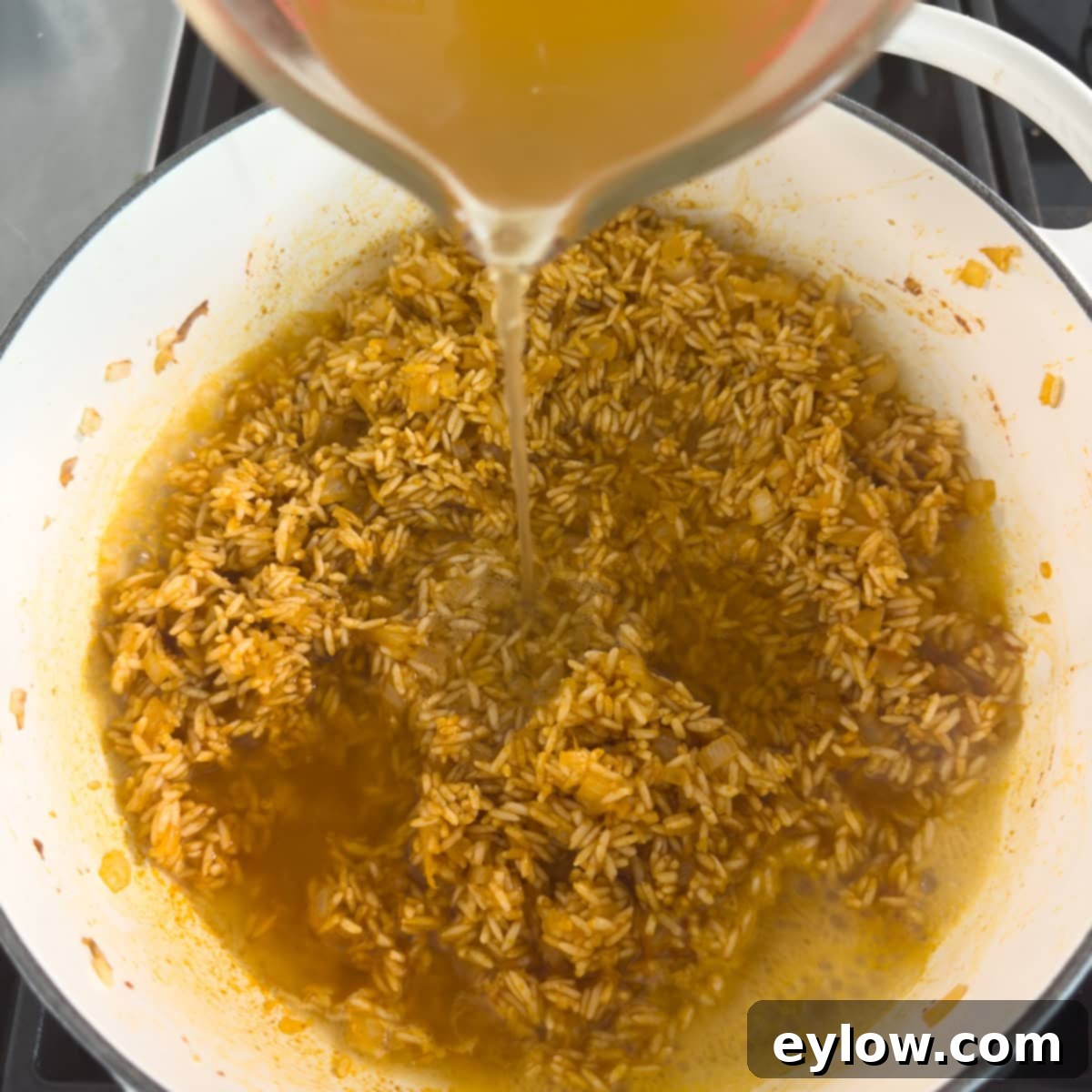
5. **Add Broth and Bring to a Boil:** Pour in the chicken or vegetable broth. Give it a good stir to ensure everything is well combined and no rice is sticking to the bottom. Increase the heat slightly and bring the liquid to a rolling boil. This rapid heating ensures even cooking once covered.

6. **Cover and Simmer:** Once boiling, immediately place a tight-fitting lid on the pot. Reduce the heat to the lowest setting possible. Cook undisturbed for exactly 15 minutes. It’s crucial not to lift the lid during this time, as the steam is essential for perfectly cooking the rice.
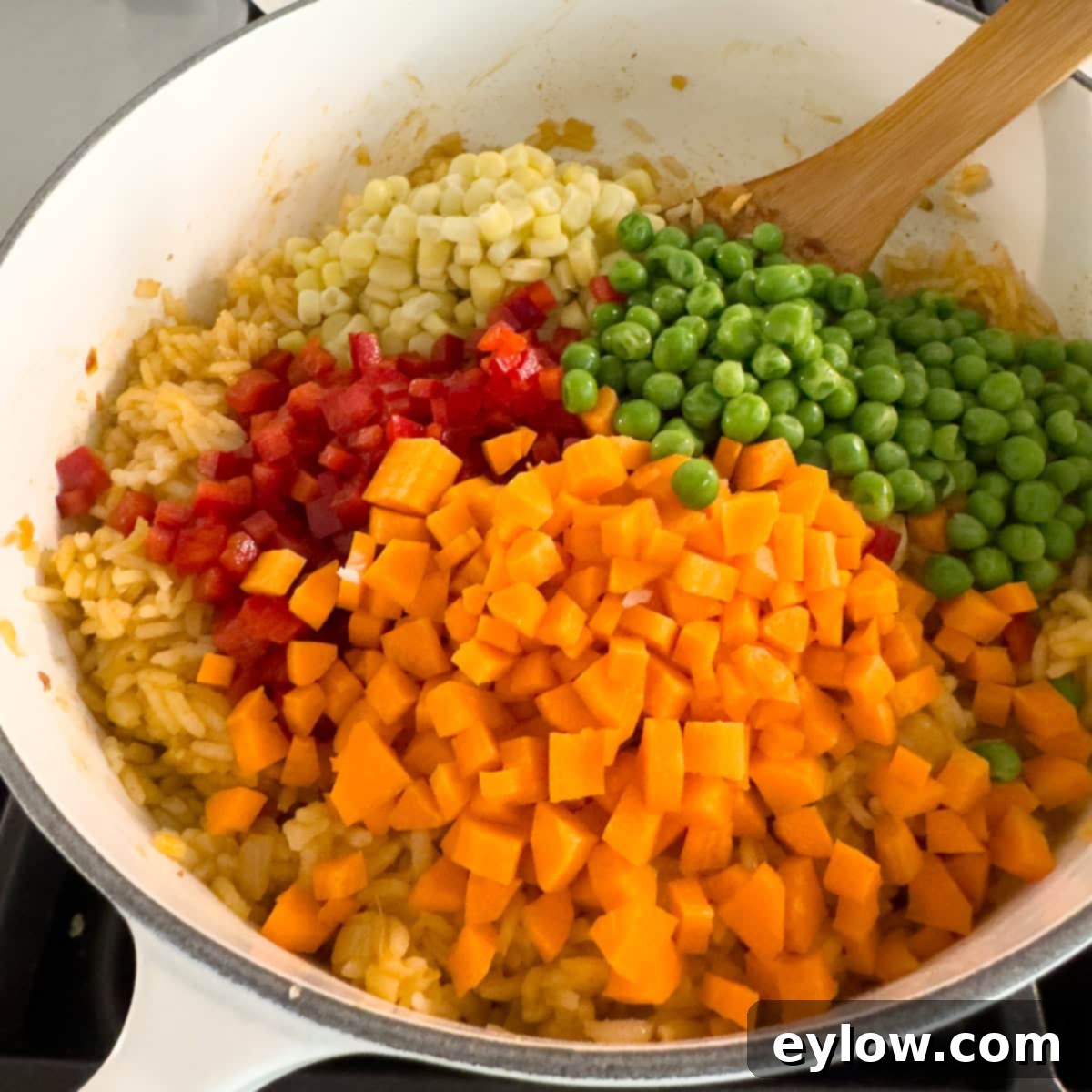
7. **Add Vegetables and Steam-Finish:** After 15 minutes of simmering, remove the lid quickly, give the rice a gentle stir with a fork to fluff it slightly, then immediately scatter the thawed peas, corn kernels, finely chopped carrots, and red bell pepper directly on top of the rice. Do not stir the vegetables in yet. Replace the lid securely and turn off the heat completely. Let the rice and vegetables steam-finish for another 10 minutes. This final resting period allows the vegetables to gently cook in the residual heat and the rice to fully absorb any remaining moisture, ensuring maximum fluffiness.
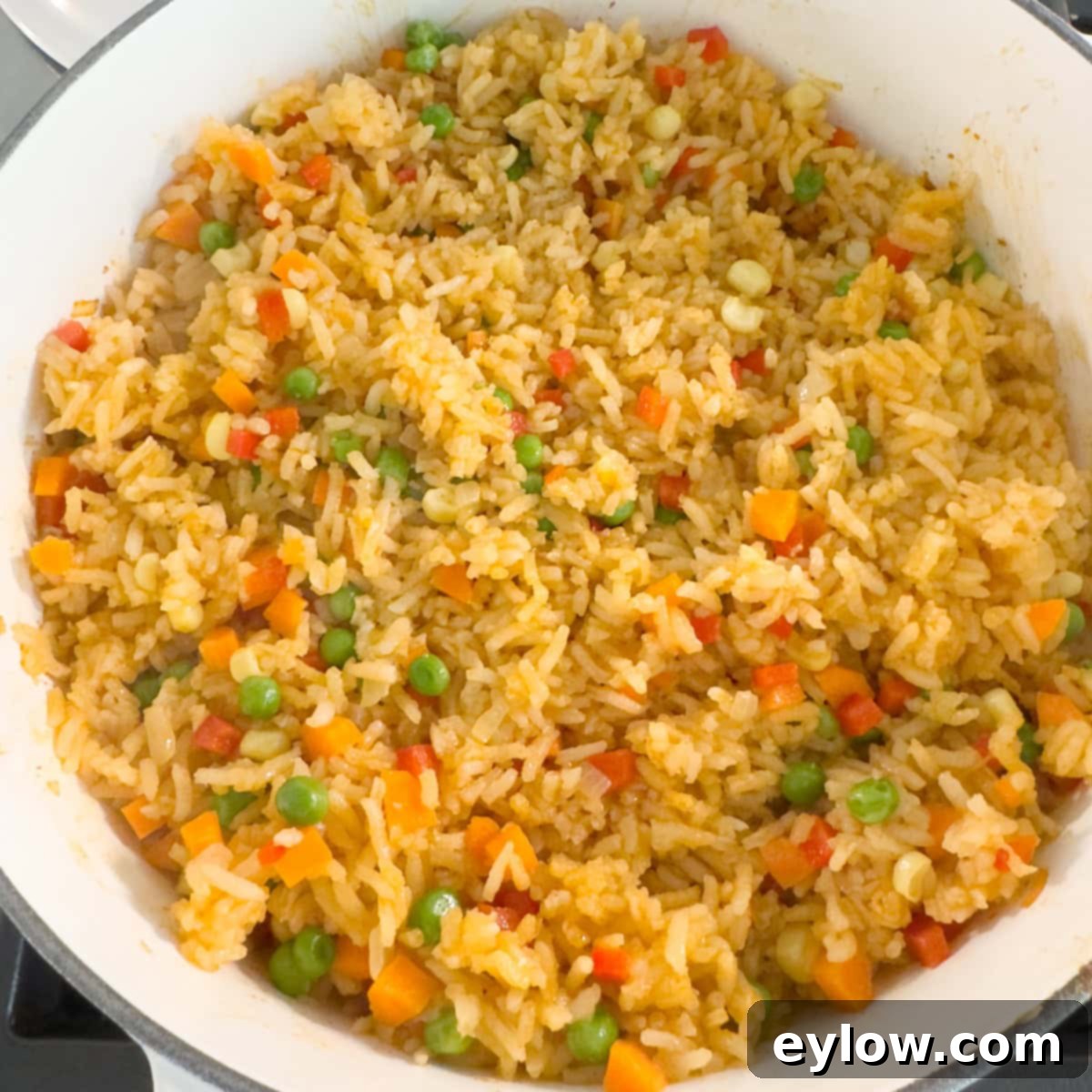
8. **Fluff and Serve:** Once the 10-minute steam-finishing time is up, remove the lid. Fluff the rice gently with a fork, incorporating the colorful vegetables throughout the dish. Taste and adjust seasoning with more salt and black pepper if desired. Garnish with fresh chopped cilantro or parsley for an extra burst of freshness and color. Your perfectly cooked, flavorful vegetable rice is now ready to be served and enjoyed!
Chef’s Tip: Stock vs. Broth – Understanding the Nuances: The terms “broth,” “stock,” and “bone broth” are frequently used interchangeably in recipes, but there’s a subtle distinction that can impact your cooking. Traditionally, stock and bone broth are made by simmering animal bones (often with some meat and aromatics) for extended periods—hours, sometimes even a day—to extract collagen, gelatin, and a richer, more viscous body. This results in a flavorful base that becomes gelatinous when chilled. Broth, on the other hand, is generally made by simmering meat, vegetables, or both for a shorter duration, yielding a lighter, more flavorful liquid that usually remains liquid when chilled. While “vegetable broth” is common, technically, there’s no such thing as “vegetable stock” because stock relies on bones for its unique properties. However, for most home cooking, including this recipe, the terms are interchangeable enough. Don’t let the label overcomplicate things—simply use a good quality chicken or vegetable broth you have on hand for excellent results.
Delightful Serving Suggestions
This versatile vegetable rice is a perfect canvas for countless main course pairings, elevating any meal from ordinary to extraordinary. Its vibrant flavors and appealing colors make it a fantastic companion to a variety of proteins and cuisines:
- Classic Roast Chicken: Pair it with tender roast chicken breasts or a whole roasted chicken. The savory notes of the chicken beautifully complement the earthy spices and fresh vegetables in the rice.
- Zesty Chicken Salsa Verde: For a meal bursting with bright, tangy flavors, serve your vegetable rice alongside chicken salsa verde with its delightful tomatillo sauce. The rice provides a wonderful balance to the piquant chicken.
- Grilled Fish or Shrimp: Light and flaky grilled white fish like cod or tilapia, or perfectly seared shrimp, make for an excellent protein option. The freshness of the seafood marries well with the vibrant veggies in the rice.
- Hearty Pork Chops: Enjoy it with pan-seared or baked pork chops for a comforting and satisfying dinner.
- Vegetarian Mains: For a complete vegetarian meal, serve it with black bean burgers, grilled halloumi cheese, or a simple lentil soup. The rice itself is rich enough to be a central component of a plant-based plate.
- As a Base for Bowls: Use the vegetable rice as the base for a Buddha bowl. Top it with roasted chickpeas, avocado slices, a drizzle of tahini sauce, and your favorite greens.
To complete your meal, all you need is a simple, crisp tossed green salad dressed with a light homemade vinaigrette. And for an extra touch of creamy indulgence and healthy fats, be sure to add some fresh, creamy diced avocado to your plate. The combination of flavors and textures will create a truly memorable dining experience.
Storing and Freezing for Future Enjoyment
One of the many benefits of this mixed vegetable rice is how well it stores, making it perfect for meal prep and ensuring you always have a delicious, healthy option readily available.
- Refrigerator Storage: Leftover vegetable rice can be safely stored in the refrigerator for 4-5 days. To maintain its freshness and prevent bacterial growth, ensure the rice is cooled quickly after cooking (within one hour is ideal) and then transferred to an airtight container. This helps to lock in moisture and flavor while preventing contamination.
- Reheating Instructions: When you’re ready to enjoy your leftovers, it’s crucial to heat the rice thoroughly to at least 165°F (74°C) for food safety. You can reheat it in a microwave, stirring occasionally until piping hot, or gently warm it on the stovetop with a splash of water or broth to prevent it from drying out.
- Freezing for Longer Storage: For extended storage, this vegetable rice freezes beautifully for up to 3 months. This is a fantastic option for busy individuals or anyone looking to minimize food waste. To freeze, allow the rice to cool completely. Portion it out into individual servings in airtight freezer-safe containers or heavy-duty freezer bags. I personally love freezing mine in these freezable containers, which create perfect portions that are easy to pop out. Label your containers with the date for easy tracking.
- Thawing and Reheating Frozen Rice: When you’re ready to eat, simply transfer a frozen portion directly to the microwave. Heat on high, stirring occasionally, until it’s steaming hot all the way through. Alternatively, you can let it thaw in the refrigerator overnight and then reheat on the stovetop or in the microwave. Freezing and reheating works like a charm, preserving much of the original texture and all of the flavor!
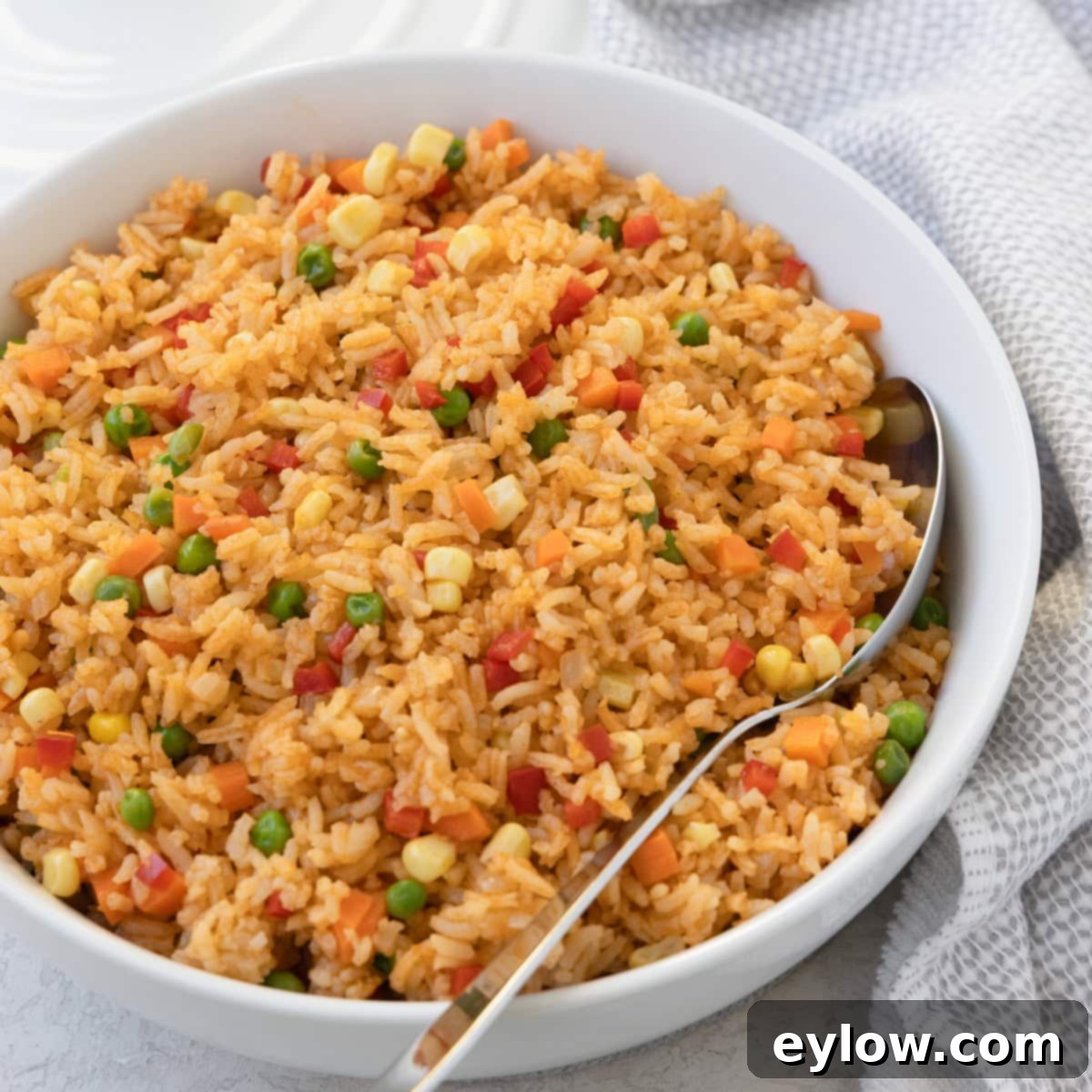
Frequently Asked Questions About Vegetable Rice
For the fluffiest, most separate grains, long-grain rice varieties like basmati or jasmine work best. Basmati is my top recommendation due to its distinct aroma and light texture, ensuring your vegetable rice is never sticky or clumpy. While jasmine rice is also a long-grain option, it tends to be softer and slightly stickier than basmati.
Several key steps will help you achieve perfectly fluffy rice. First, ensure you use the correct liquid-to-rice ratio, which is typically 1 ¾ cups of liquid (broth in this case) per 1 cup of white basmati rice. Second, resist the urge to overcook it; stick to the recommended cooking time of 15 minutes. Most importantly, do not lift the lid during cooking. Finally, allow the rice to steam-finish, covered, for at least 10 minutes after cooking before fluffing it gently with a fork. This resting period allows the grains to firm up and absorb residual moisture.
Yes, you can certainly make vegetable rice using water instead of broth. However, using water will result in a milder flavor profile. To compensate for the reduced depth of flavor, I recommend stirring in a generous amount of fresh herbs, such as parsley or cilantro, at the very end of cooking. You might also consider adding a flavorful spice like a pinch of saffron for color and unique taste, or some smoked paprika for a warm, earthy essence, to enhance the overall sensory experience.
Vegetable rice is incredibly versatile and complements a wide array of proteins. Excellent options include grilled chicken breast, succulent pork tenderloin, pan-seared shrimp, baked tofu, or even hearty beans (like black beans or kidney beans for a vegetarian option). These proteins can be served alongside the rice or even gently stirred in at the end of cooking to create a complete, one-dish meal.
This recipe is easily adaptable for vegan and vegetarian diets. Simply ensure you use vegetable broth instead of chicken broth. All other ingredients are plant-based, making it a delicious and inclusive option for everyone.
Absolutely! The beauty of this recipe lies in its flexibility. Feel free to experiment with other spices. For an Indian-inspired twist, add a pinch of turmeric for color and a slight peppery note, or a touch of garam masala. For a more Mediterranean flavor, try adding dried oregano or a bay leaf during the simmering stage. Always taste and adjust to your preference!
More Terrific Recipes with Rice You’ll Love
We are truly passionate about rice in all its wonderful forms and colors! From hearty soups to flavorful main courses and essential cooking tips, there’s always something new to explore. Perhaps some of these other fantastic recipes that feature rice, or provide guidance on cooking it, will capture your interest and become new favorites in your culinary repertoire.
- Hearty Turkey and Wild Rice Soup with Leftovers
- Classic Saffron Risotto (Risotto Milanese)
- Essential Tips: How to Reduce Arsenic in Rice
- Fast and Flavorful Instant Pot Chicken Rice Soup Recipe
Did You Make This Recipe? We’d Love to Hear From You!
If you’ve taken the time to create this delicious vegetable rice, we sincerely hope you enjoyed every flavorful bite! Your feedback is invaluable to us and to other readers who are looking for new recipes to try. Please consider sharing your experience by adding your comment below. We love hearing about your variations, tips, and how it turned out in your kitchen. If you absolutely loved it and it earned a spot in your recipe rotation, please be sure to give it a 5-star rating! Your ratings and reviews truly help others discover and enjoy this wonderful dish, and we deeply appreciate your support.
📖 Recipe

Vegetable Rice
Sally Cameron
Pin Recipe
Equipment
-
Medium pot 3 ½ quarts
Ingredients
- 1 ½ cups white basmati rice
- 1 ½ tablespoons extra virgin olive oil or avocado oil
- 1 cup chopped white onion 1 small onion
- 2 large garlic cloves
- ½ teaspoon ground cumin
- ½ teaspoon ground coriander
- 1 tablespoon tomato paste
- ½ teaspoon sea salt
- ¼ teaspoon ground black pepper
- 2 ½ cups low sodium chicken broth or vegetable broth
- ½ cup peas frozen, thawed
- ½ cup corn kernals frozen, thawed
- ½ cup finely chopped carrot 2-3 carrots
- ½ cup finely chopped red bell pepper half of a large pepper
- 1 tablespoon fresh chopped cilantro or parsley optional garnish
Instructions
Wash rice
-
Add the rice to a sieve and rinse well under cold running water for 1 minute. Drain and save for cooking.
Cook rice
-
Add the oil to a heavy medium pot (3 ½ quarts) over medium heat and saute the onions until soft, 3-4 minutes. If they start to brown turn the heat down. Add the garlic and cook 1 minute more.
-
Add the spices, tomato paste, salt and pepper, and stir, cook 1-2 minutes until it’s mixed and fragrant. Add the washed drained rice and toast for 5 minutes, stirring.
-
Add broth to the pot and stir. Turn up the heat and bring to a boil, cover with a tight fitting lid and turn heat to low. Cook rice for 15 minutes.
Add vegetables
-
At the end of 15 minutes, stir the rice quickly then add all of the vegetables right on top of the rice. Cover with the lid, turn heat off and allow to steam finish for 10 minutes. Taste and season with more salt and black pepper if desired.
